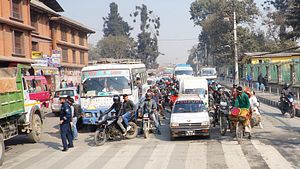KATHMANDU – Nepal’s government has decided to purchase 300 electric public buses considering the impending climate crisis posed by unabated air pollution in the nation’s capital. Experts, however, believe that this move might not be enough to decrease air pollution in the Kathmandu Valley despite the country aiming to convert 20 percent of all public vehicles into battery run ones by 2020.
Home to more than 3 million residents, the Kathmandu Valley today chokes under a blanket of toxic air. The cause of this climate epidemic is due to the surge in diesel- and petrol-run vehicles. According to the Department of Transport Management (DoTM), as of the fiscal year 2016-17 119,956 vehicles were registered in the Bagmati zone. This includes 1,405 buses, 2,132 minibuses, 14,542 cars and jeeps, 222 microbuses, and 94,751 motorcycles. In the absence of proper public transportation, the ownership of private vehicles continues to soar, complicating the situation.
The Kathmandu Valley is vulnerable to air pollution, mainly due to its geography. The valley is surrounded by massive hills, giving it a bowl-like topographic shape. This leads to restrictions in wind movement and pollutants linger in the atmosphere. The situation worsens during the winter season (November to February) because of thermal inversion, which occurs during the early morning and late night. The cold air that arrives from the mountains gets trapped under the layer of warmer air, which then acts a lid. This results in pollutants hovering close the city ground for a lengthy period of time. Thus, air pollution in the Kathmandu Valley during winter escalates to dangerous levels, posing threats to its denizens.
Vehicular emissions are one of the key contributors to air pollution in Kathmandu, apart from dusty roads, brick kilns, and construction work. Keeping aside other factors, vehicle emissions remain in the top spot as it is a large and growing source for air pollution in the Kathmandu Valley, mainly due to the continuous sale of petrol- and diesel-run vehicles.
Air pollution in Nepal’s capital city, Kathmandu, is on the rise over the years, partly due to the ever-increasing number of carbon-emitting vehicles. The annual ambient particulate matter (PM2.5) concentration above 40 micrograms per cubic meter (m3) is considered unhealthy in Nepal; the World Health Organization (WHO) has set the tipping point at 25 µg/m3. The particulate matter is often 10 times higher in Nepal than the WHO’s annual guidelines.
The increased PM2.5 levels in the Kathmandu Valley and the rapid surge in vehicles are interconnected. They are symbiotic in nature and repeated reports, including “Dynamics of PM2.5 concentrations in Kathmandu Valley, Nepal;” “Toxic smog: the new normal in South Asia;” and “Air Pollution in the Hindu Kush Himalaya” prove it. Meanwhile, the Nepali government remains oblivious and indifferent to this fact.
The problem aggravates when Nepal has put the legal limit for the particulate matter at 40 μg/m3 against WHO’s 10 μg/m3 annual mean, or 25 μg/m3 24-hour mean. According to the Department of Environment Air Quality Monitoring, on August 6, 2019, the 24-hour average of PM2.5 was 15.578 µg/m³ based on the data collection of Phora durbar KTM station, 2.172 µg/m³ at Ratna Park station, and 10.691 µg/m³ at the U.S. embassy station. This level, however, is due to the ongoing monsoon. Pollution gets severe when there’s no rain in the valley. For example, the same Ratna Park station recorded PM2.5 at 109.08 μg/m3 on January 3 this year, and 144.19 μg/m3 in December. This shows that when there’s no rain the level of PM2.5 increases drastically.
Nepali Prime Minister K.P. Oli has lofty plans to reduce dependence on fossil fuels by 50 percent or more by the year 2050. With that aim in mind, the government recently handed more than $2.6 million to the Sajha Yatayat Cooperative for the purpose of buying 300 electric buses, hoping to launch the services within the next 10 months. The bus operator already runs five electric buses in Kathmandu valley.
Dr. Sumi Mehta, a senior epidemiologist for Vital Strategies’ Environmental Health division, said, “300 electric buses are a great start, and a visible sign of the government’s commitment to air quality, but will not be sufficient to improve air quality in the short or long term.”
“Vehicle emissions are a leading and growing source of air pollution within Kathmandu. Urgently required are measures to ensure cleaner public and private forms of transportation. Even if the entire bus fleet could run on electricity, world-class fuel and emission standards need to be enforced to promote clean air,” she adds.
Given the scale of the problem, the 300 electric buses might serve as a demonstration fleet to inform longer-term plans and learn how these vehicles function in the weather, what terrain duty cycles are needed locally, what charging infrastructure is needed, and how to handle maintenance and reliability.
Although experts and the government seem to be in a jubilant mood, reports say that electric vehicles are not 100 percent pollution-free. According to expert Frank Kelly, electric vehicles do not emit exhaust fumes, but they still produce large amounts of tiny pollution particles from brake and tire dust. The government, for now, has no regulations to measure and accept a safe limit for electric vehicles in Nepal.
If the Nepali government doesn’t place a ban on the sale of diesel- and petrol-run vehicles in the Kathmandu Valley, people will continue to own them. In this sense, a longer-term transition to electric buses should not be a substitute for addressing vehicle pollution in the near term. The addition of 300 electric buses, without phasing out the old ones, will only add to existing problems, including traffic congestion as well as air pollution.
Arun Budhathoki is the Climate Tracker South Asian Hub Fellow 2019.

































